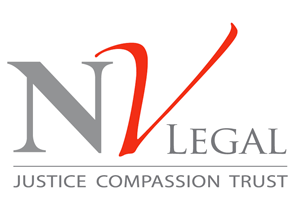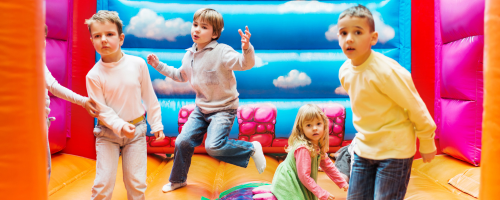Bounce smart, bounce safe: A guide to ensuring children’s safety on inflatables
Bouncy castles and inflatables are common sights at birthday parties, carnivals, and family events.
However, these inflatable attractions can pose significant risks to the safety of those on them. Resulting in countless injuries every year.
From unexpected accidents to inadequate supervision. There are potential dangers for the children on them. Our client knows only too well what can happen at an unsupervised attraction.
CASE STUDY – INFLATABLE OBSTACLE COURSE
A family fun day at ExCeL London turned into an unexpected ordeal. Our client, accompanied by his parents, ventured to the Kidtropolis section of the venue.
Bouncy castle obstacle course
Within the centre of ExCeL, was Kidtopolis which included an inflatable obstacle course.
The child wanted to play on the course. There were no visible age restrictions so his parents allowed him to enter.
As they were checking on their child to see him on the inflatable bouncy castle course, it became clear the area was busy. Despite the number or children on the course, no staff members were visible to assist the children.
Bouncy castle injury
After a short while, another concerned parent brought the child to his parents. The child was now in tears and cradling his left arm.
An older boy had pushed him, causing him to tumble from the unsupervised inflatable. He landed awkwardly on his left arm. The consequences resulted in severe injuries. A fracture of the arm, dislocated elbow, and a psychological injury.
Journey to recovery
After receiving medical care, our client’s fractured arm and dislocated elbow healed and he thankfully recovered from the psychological injuries. Experts were instructed in the case to prepare reports for the court.
After issuing legal proceedings, the defendant continued to deny responsibility for the incident. We prepared the case for trial and the defendant made an offer to settle.
After careful consideration, our client accepted the offer and the case settled for £8,000.
There was an application for an infant settlement approval hearing and a judge approved the settlement.
How safe is the bouncy castle ?
There are some simple checks that the operator or you can do before allowing your child onto a bouncy castle or inflatable.
Most accidents are preventable. You don’t want to alarm your child, but you do want to maximise their safety.
Adequate supervision
Ensure there is a designated adult supervisor or trained operator always present. They should be responsible for monitoring the children’s activities, ensuring fair play, and addressing any safety concerns that may arise.
Age and weight restrictions
Consider age and weight limits specified by the manufacturer or operator. Restricting access to children within the appropriate age and weight range helps prevent overcrowding. It also ensures that the structure can support the children safely.
Secure anchoring
Verify the bouncy castle is securely anchored to the ground and set up according to the manufacturer’s instructions. This includes properly inflated air chambers and securely fastened stakes or weights. There should be enough padding around the structure to minimise the risk of falls or collisions.
Inspections and maintenance
Inspect the bouncy castle for any visible damage. Including tears, loose seams, or deflation. Ensure the equipment is well-maintained and inspected by a professional.
Safety instructions and rules
Check the safety instructions and rules for the equipment. Teach your child the importance of following these guidelines. Such as avoiding rough play and not climbing on the walls or netting. Remove shoes, jewellery, or sharp objects before entering the inflatable.
Proper attire
Ensure users wear appropriate clothing. Such as comfortable and snug-fitting attire, to prevent entanglement or tripping hazards. Remind them to remove any sharp objects. Including belts or accessories, that could puncture the inflatable.
Weather conditions
Be alert to the possibility of adverse weather conditions that may pose risks to inflatable play. Strong winds, thunderstorms, or excessive heat can compromise the stability and safety of the structure. It is crucial to follow the operator’s guidelines. Evacuate the bouncy castle if weather conditions deteriorate.
Hygiene and sanitisation
Implement cleanliness and sanitisation practices. Ensure that children wash their hands before and after playing on the inflatable. This minimizes the spread of germs and prevents infections.
Parental awareness
Stay vigilant and observe your child’s behaviour while they are on the bouncy castle. Keep an eye out for overcrowding, rough play, or any signs of discomfort or distress. Encourage open communication with your child. They should feel comfortable reporting any safety concerns to you.
These are a few ways to reduce the risk of injuries on bouncy castles. Proper supervision, following safety guidelines and age-appropriate use of bouncy castles are key.
Additionally, regular maintenance and inspection of the inflatable structure are essential. This identifies and addresses any potential hazards.
Bouncy castle – common injuries
Five common injuries that can happen on bouncy castles are:
-
Fractures and sprains
Due to the nature of bouncing and jumping, fractures and sprains are common injuries on bouncy castles. Landing awkwardly or colliding with other participants can lead to fractures in bones. Particularly in the arms, legs, or wrists. Sprains, which involve the stretching or tearing of ligaments, can occur from sudden twists or falls.
-
Head and neck injuries
Collisions, falls, or striking another person can result in head and neck injuries. These injuries range from minor bumps and bruises to more severe concussions and brain injuries. These may occur if a child’s head hits a hard surface within the bouncy castle, if they collide with other children or fall out of the inflatable onto a hard surface.
-
Cuts, bruises, and abrasions
Falls or contact with sharp edges or objects within the bouncy castle can cause cuts, bruises, and abrasions. These injuries typically happen when children lose balance or collide with the walls, netting, or poorly maintained parts of the inflatable structure.
-
Soft tissue injuries
Strains and sprains in muscles or tendons. Particularly in the ankles and knees, can occur from sudden movements or landing improperly on the bouncy castle, or when the inflatable is overcrowded. Overexertion or repetitive jumping may also lead to muscle strains.
-
Impact injuries
Accidental collisions between children can result in impact injuries. These injuries may involve blunt force trauma to various parts of the body. Causing pain, swelling, and bruising.
Considering these safety precautions, proprietors can reduce the risk of accidents. Ensuring a safe and enjoyable experience for participants on inflatable bouncy castles and attractions.
NV LEGAL
NV Legal has a specialist team of solicitors. Experienced in successful outcomes for accidents involving children and adults injured on inflatables and bouncy castles.
If you or someone you know has questions about these issues, contact us for free legal advice.
Consultations are FREE of charge. Advice is from qualified solicitors, regulated by the Solicitors Regulation Authority.
Call – 03308 281 586
Email – info@nvlegal.co.uk
Website – www.nvlegal.co.uk
Find us on social media – Facebook LinkedIn
USEFUL LINKS
Claiming compensation when a child has been injured in an accident


